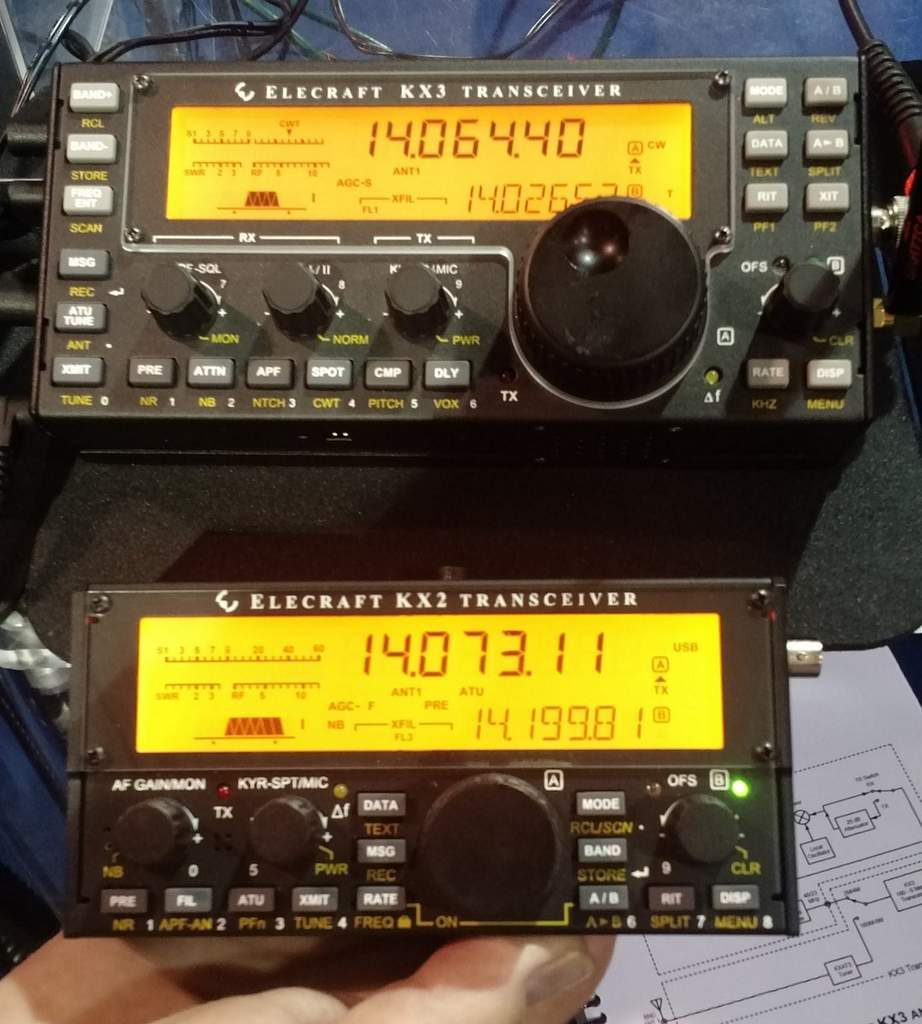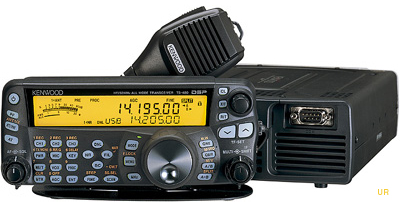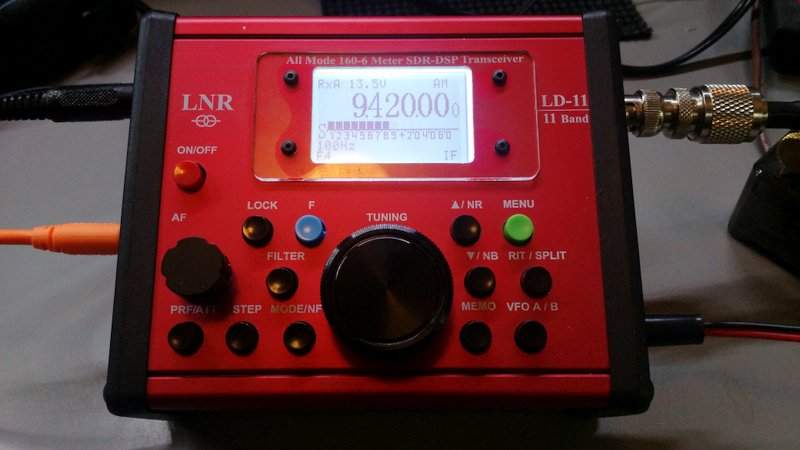
The Yaesu FT-890: One of many general coverage HF transceivers spotted in the 2017 Hamvention flea market.
Many thanks to SWLing Post reader, Joe, who writes:
I’ve been practicing for my Technician ham radio license here in the US and am ready for the test. I’m already looking at HF transceivers even though I don’t have my General license yet.
Here’s what’s important to me:
- I will still do a lot of SW DX
- Something that has at least decent audio
- Something that isn’t too too huge; though I’m a little flexible on size
- I need something that has a receiver that handles weak DX well
I’d be comfortable spending $500 any day all day no problem. Anything higher than that and I’d really have to think it’s an investment in my radio future.
Thanks for your question, Joe, and allowing me to post it here for comment as this is one I’m frequently asked.
First of all, congratulations on studying for and taking your ham radio license exam! I’m a ham and absolutely love the radio privileges my license provides.
At the same time, I’m still more of an SWL than a ham–meaning, I spend way more time chasing SWL DX than doing on-air ham operations.
With that said, I always seek radios that will serve me well as both a ham and SWL, if possible.
My humble advice
If we stick with your $500 budget strictly, then we’re certainly looking at used transceivers. That’s okay–there are many good ones on the market!
I posted the following review of general coverage transceivers a few years ago. The info in it is still very much accurate in the used market. I would suggest you give it a good review as it goes into more detail about the ins and outs of your first transceiver and the importance of leaving budget to purchase a good power supply:
The best general coverage transceivers for shortwave listening
Click here to read the full review.
If you’re willing to spend a bit more than $500…
I’m a big fan of the Elecraft KX3 and Elecraft KX2. I have both and use them frequently.

Comparing the size of the Elecraft KX3 (top) and KX2 (bottom) at Elecraft’s Dayton Hamvention booth.
You can find the KX3 used for $700-900 (depending on options). The bare-bones model of the KX2 can be purchased new from Elecraft for $749.
Of course, something to keep in mind about the Elecraft KX series transceiver is that output power is limited to 12-15 watts. Some of the general coverage transceivers mentioned in our review have a much higher 100 watt output power.
Additionally, the audio fidelity (via the internal speaker) is not as good as many other general coverage transceivers. Audio amplification is not as powerful, because both transceivers are designed to operate on a small battery pack (a major plus in my world because I love field-portable rigs).
Since I do 90% of my radio work with headphones, audio amplification is not a problem for me and I’m quite please with both KX line transceivers. Many KX series owners purchase external amplified speakers to improve audio.
While we’re looking at QRP transceivers, I would also recommend the LnR Precision LD-11. Its broadcast afidelity is even better (via headphones) than the KX2/KX3 since the AM filter can be widened to an impressive 9.6 kHz. It’s a top-notch transceiver and can be purchased new for $780 US. Click here to check out my full review of the LD-11.
Of course, as I mention in the general coverage transceiver review, the Icom IC-7200 is also a gem of a transceiver.
Keep in mind, the ‘7200 was such a popular radio that after Icom discontinued the model in January of 2016–due to overwhelming customer demand–they re-introduced it earlier this year. No kidding.
New, the IC-7200 is about $879 US, but they can be found used closer to the $650 – 750 mark. A very good value in my book. In fact, I’m very tempted to buy one as my 100 watt “shack and field” rig. It’s way more user-friendly on Field Day than my Elecraft K2/100 and, in many ways, a better option than purchasing an Elecraft amp for my KX3/KX2.
Any other good suggestions?

The Kenwood TS-480SAT is full-featured, small, and has a detachable face plate. A very good general coverage transceiver.
There are hundreds of HF transceivers on the new/used market. I’m sure I’ve missed some excellent options in this post and my general coverage transceiver review.
Please comment with your favorite dual-purpose Ham Radio/SWLing rig. Tell us why you love it!



I am new to these transceivers. As per my knowledge, transceivers are going to play a dominant role in our lives pretty soon. As per my opinion, an excellent antenna gives better quality of transmission and response.
Besides an IC-703 (QRP 10 W) I am still using a Kenwood TS-480 (100 W).
The main reason here for choosing them was a good receiver for shortwave listening. But these radios are also excellent options for operating on the ham bands, of course. Since I have a very high noise level at home I am operating portable all the time.
Maybe you can find a used Icom IC-7300 (100 W) for a good price when the new IC-7610 becomes available later this year. The 7300 is very popular and I am convinced many users will upgrade to a 7610. The IC-7300 is an SDR transceiver with a decent front panel and provides quite a good receiver – as long as you don´t connect it to a logperiodic 🙂
Hope to meet you on the bands very soon, Joe.
vy73
Harald
DL1ABJ
I went with the Icom 746pro and Icom 703. Proven dx radios and provides vlf coverage that the Yaesu radios dont
+1 for the IC-703…great SWL radio.
You can also check the equipment reviews on eham.net for ratings of different transceivers, and the used equipment and photos of past equipment sold in Universal Radio’s website. There’s lots of good information there.
My vote is for the FT-980 because it is the only one I am familiar with. It has good adjacent channel IMD performance in a RF rich environment. In fact they all could be good candidates I don’t know about because these are poster children for field day. It gets more complicated that they also contain transmitters creating other competing ease of use factors where you may give a little for better transmitter performance. This needs a Betty Crocker bake-off. field day is coming up.
Love the 890. I have 2 of them.
The YAesu FT-450D is one of the best ‘entry level’ transceivers on the market, its a lot of bang for the buck. I’ve had mine 18 months now and cant fault it. A second hand one would come in at less than $500.
I would have to agree . The ft 450 is a great starter radio.
Well, for $500.00, I picked up a used Kenwood TS-50S. Yes, a very barebones HF rig for sure, but tried and true. It works at -10 degrees F (And yes, I’ve used it that cold as well as it’s sister 6M rig the TS-60S!). It’s not a bad AM rig either for TX and RX on 29.000MHz, 7295kHz, or even 3885kHz. (You have to reduce the Mic Gain for that, Just a quick one-step). And, there are mods on sites like http://www.mods.dk that show you how to open the TX wide for the newer 60M band. (BTW, also goto mods.dk to see how to modify and wire an Astatic D104-M6B hand mic to this and other 8 pin Kenwood rigs, and have it powered by the +8VDC from the radio itself. Bye-bye 9VDC battery!) Nice receive on this rig. Hears way better than my TS-2000X, albeit it does not have the nice deep-bass audio quality that the TS-2000 does. TX audio is good and punchy and power settings are 10W, 50W, and 100W, (AM it’s 5W, 12W, and 23W.) Oh, and there’s all the FM functions required for 10M FM repeater work with CTCSS. (Not back for its time of this rig’s release in the early 1990’s.). So, ya see one of these rigs for $500.00, or less, worth it!
Excellent! Yes, I often forget about this Kenwood model as well. Thanks for the recommendation!
My impression is that Joe “saddles the horse from the back” as a German proverb goes: The selection of a transceiver should be the last decision in a longer chain.
I would start with a better SDR like the SDRplay and an active antenna like the Bonito Whip. Using this equipment I would evaluate my possibilities: If RFI makes certain portions of the spectrum unusable this lowers the possibilities. Perhaps the decision will be to move to mobile or portable operation.
Next step: A reasonable choice of antennas. If everything below 10 MHz is polluted, a smaller antenna (or several) should be erected. On the higher frequencies the combination of a good antenna and QRP gets more attractive.
Depending on how much computer I can tolerate in the shack, a combination of the SDR from above and a quite cheap transceiver might be attactive. The most important decision about the transceiver would then be the computer interface. You could operate two seperate paths: One from the active receiving antenna through the SDR to the computer, and the other from computer and microphone etc. to the transceiver and the transmitting antenna. This would include a homebrew part where you protect the receiving path from the TX energy.
In every case you should remember what hams have known for 100 years: A good antenna is the best RF amplifier.
Good points. The antenna is certainly a critical part of the system. At some point (when time permits!) I’ll tackle antennas as well. 🙂
I agree that an SDR/transceiver combo would get more “bang for buck.” Indeed, many SWLs already have an SDR (receiver) in their arsenal. sIn this case, I’m addressing those that are simply looking for a transceiver, but just want to find a rig that could double as a good tabletop RX.
Even with a transceiver you can still evaluate if your environment is suitable to operate in or if you need to go mobile. Most entry level transceivers will work perfectly fine as a mobile as well. My suggestion is get an Icom 718, decent general coverage receiver, easy to use, and they have been around for a long time so there’s plenty of them out there.
A QUALITY ANTENNA IS THE BEST WAY TO IMPROVE EVERYTHING A TRANSCEIVER IS EXPECTED TO PERFORM.
I was in the market for a new (to me) radio recently and receive capability was my top priority as a ham and as a SW listener. As we say as amateurs, if you can’t hear them you can’t work them. I ended up with a Kenwood TS-590S (not the newest “G” model).
Its receive capabilities are ranked as one of the highest, not just in its price range, but of most receivers out there. It has features which will last into the future, such as a built-in sound card interface which comes in really handy for digital work as well as receiving various non-amateur digital signals across the SW bands.
I have seen these running for $700-850, with prices edging lower toward $700 recently.
Just my 2 cents worth! Cheers!
I agree–that TS-590S is a great rig! Thanks, Robert!